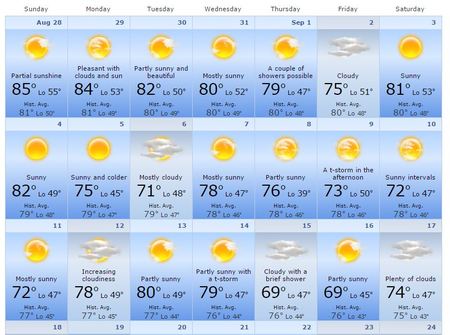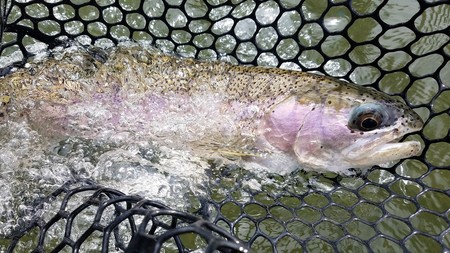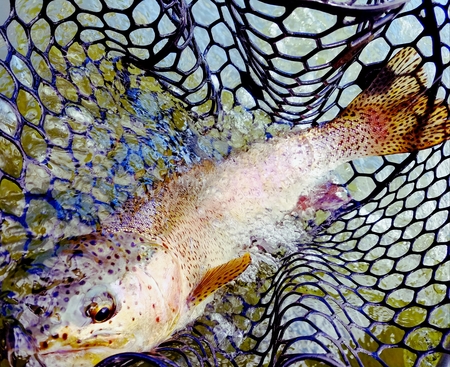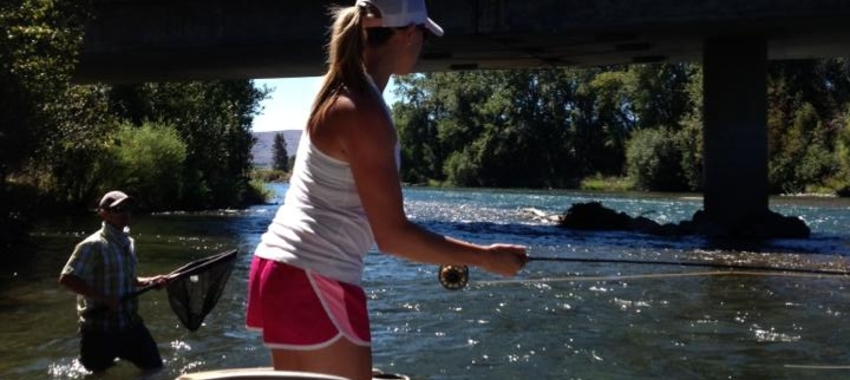Tips for Growing Larger Trout
August 25, 2016
Sometimes I feel like a trout shepard or a fish farmer. Year after year we see the trout grow, reproduce, and eventually die and pass their holding lies onto the next generation. My flock is out there swimming around every day ducking and dodging all the adversity coming at them, and its my job to help keep the herd safe and healthy. While I can't save them from everything I do want you guys to be aware of how special the trout are here in the Yakima Canyon. Lately I have been working directly with a ton of customers in the shop and in classes (not writing blogs as you can tell:), and I find myself glancing out the window wondering how the herd is doing. Our team guides over the same water day in and day out and to think we lost some trout is unfortunate. These trout will be missed. Literally. Although in nature, nothing goes to waste I suppose. However, I want to share some tips and reflections that I have about trout handling in growth during this critical time.
The water is very warm at the time being, but the water temps will drop and the fishing will pick up steam and the flock will become healthy again as we turn the corner into fall. It has been very tough fishing this past week. We have been in this hot and stagnate weather pattern and the fish have their best defenses up. There hasn't been any significant water or weather change to bump them around, and once they live in one spot for a week they get very good at recognizing which flies are real versus fake! This is good for trout, bad for the trout fisherman. We are still getting some decent fish however, but it is critical to let 'em swim. Don't pick up, don't take a photo of it out of the water! Releasing fish efficiently is key to their survival.
The next couple of weeks will some of the busiest days of the year, and who could blame em? The weather is great and the water is ideal. It will drop to about 50% of the current volume in the next few weeks. It will be perfect for anyone wanting to rent their own boat by the way. As irrigation demand decreases, so will the river flow in the Yakima Canyon. Its my favorite time of year. The river is just high enough for some cutbank action on certain stretches but low enough to wade and run a personal water craft.
Extended Weather and Water Flow Forecast
As the weather cools down next week and the nighttime lows begin to creep into the 40's it should be GOOD fishing! Look for cloudy days to offer the very best dry fly fishing.

Become a Steward of the Trout

The #1 way that you can help this fishery be better tomorrow than it was today is by handling fish better, faster, and with more care. If we all handled every trout as though it were the last one on earth, this river would be INCREDIBLE! Can you imagine a Yakima Canyon where we are catching twice as many fish and they are 10-15% bigger on average? While we have no scientific evidence to support that this would happen, our tens of thousands of cumulative river days on staff here suggest that we can make a difference. We think it HAS made a difference. Our guests are reporting that the Yakima is fishing better than ever these past couple of years. We have tried to help the fishery by letting the fish go fast, unscathed, and with plenty of vigor. It is a simple way to make a difference in the fly fishing world.
Some Fish Handling Tips, but Certainly Not All of Them:
- You should never (or RARELY) ever have to revive a trout.
- Play them quick, handle them right, dont take them out of the water, and you should never have to revive them. I cant remember the last time I had to revive a trout.
- Pinch your barbs down flat. Then when you think they are flat, pinch them again till your fingers hurt! This is essential. Too many anglers dont pinch them down enough. If you do it right, you should be able to push that hook into your shirt material and pull it out without a fuss. Pay special attention to this. The Game Wardens will do this as a test when they check your tackle. Bring the fish in quickly.
- Dont milk the fight, dont go all hollywood trying to get a picture of a bent rod! Be serious about landing the fish.
- Use one fly setups. Two fly rigs tangle fish, foul hook them, and can lead to extended handling times. Each time a fish gets tangled in the net it requires more handling time. If you are catching most of your fish on one fly in particular, then just fish one fly! You will tangle less, fish more, and likely catch more trout anyway.
- Long line release. This is great once you have caught a handful of trout. Just give them some slack, let them unhook themselves. The faster that trout gets back to feeding the bigger and stronger it will be in the future.
- Cut the fly off (this doesn't mean you will lose it and it likely won't stay in the fish beyond the net). I probably cut the fly off on about 20% of the fish that we land on dry flies right now. Use scissor clamps, snip the fly if it is hooked deep, swish the fish around in the net. If you followed Tip #2 the fly should float right out. No trauma to the fish, and you get your fly back! I cut the fly off regularly. It is a good idea to dry it out and retie it anyway, just snip it with scissor clamps immediately. They are so much easier to handle when there is no line attached.
- If you are having trouble unhooking the fish, give it a break. Put it back in the water and let it breath. Sometimes it will unhook itself. Dont force anything.
- A picture isnt worth killing a fish. You will notice on our blog and website that there are very few fish ever removed from the water by Reds. We believe in preserving these fisheries so that they can be an absolute top quality experience for EVERYONE! Not just our customers and guests.
- We handle fish everyday with the public, future, and our children in mind. We want the Yakima River and all our waters to be the absolute best fisheries they can be. Dont touch small trout. Leave them in the water, grab the fly, turn the hook, say goodbye.
- If you absolutely have to touch a trout, wet your hands first. Dry hands kill fish!
- Dont let fish tangle in your tippet. Sometimes I wont net fish if I feel like they are going to tangle badly. Tippet cuts the soft sensitive skin of a trout. If you suspect the trout is going to wrap up in the line when netted, try to release it without using the net. If it does wrap up, put it back in the water immediately so it can breath and possibly unwrap itself. If you absolutely have to touch a trout, hold it upside down and it will hold still.
- If you want a picture, get one of the fish laying in the net or a picture of somebody hooked up and gettin the bend
How to Make an 18? Rainbow into a 20? Rainbow

Hahahaha. Ok, now that we are done being serious we can joke around a bit. Many folks would try to make an 18" Rainbow a 20" er by holding up in front a camera, reaching it out, exaggerating, lieing!, using a fisheye lens, and photo shop. Hahaha. We want to make an 18" Rainbow into a 20" er by releasing them fast, getting them back in the water so they are tired and can continue to eat aggressively. A tired fish wont eat for days. A trout released immediately will go back to feeding right away. That is how we are going to make 18" fish become 20" fish. Good handling, quick releases, and truly barbless hooks. 20" trout on the Yakima are not common but are becoming more-so. Practice diligent fish handling and we might be writing a blog article in a few years on how to turn a 20" trout into a 22" er! Wouldnt that be cool. Thanks for reading our blog, we appreciate the support and are glad to have so many other stewards of the river like you behind us.
How to Catch Twice as Many Trout
First, you can exagerate like most anglers eating dinner and drinking beer at Canyon River Grill/Reds every weekend LOL! Or
. you guessed it. Handle fish better so that we have less mortality, more spawners, and there fore more fish. Big mature Rainbows are the reproduction base of the river. If we lose even a few big trout then our brood stock is jeopardized! The big trout are very important in this regard. Better handling = more trout in the future.
IMG_20130918_134523_454[1]
-
Joe, I want to thank you and Red's for the great blog. These are truly the Dog Day's of Summer. Warm waters with less oxygen. A death sentence if we handle the fish outside netting, reviving and releasing. You know my personal believe in never taking the fish out of the net, no matter Winter, Spring or Fall. I will be proposing the Catch and Release (not taking out of the water, just like native Steelhead) for all Native Trout to Fish and Wildlife this coming Spring 2017. Once again I'll be reaching out To Red's for your support. To all the Outfitters, Guides and DIY's, we are the Stewards of our Catch and Release waters. "Let's all Catch and Release all wild trout as if it's the last trout on earth."
-
Joe; Thanks again for the insights!! I have tried to not touch a fish while fishing for years. I really believe the tug is the drug for a fisherman anyway!! I have a couple of tools which you have at Red's Fly Shop that make releasing a netted fish very easy. If you don't have a Ketchum Release tool attached to your vest or lanyard they work great. I also have a Guides Choice Fish Release tool. Both work great as you can easily slide your line into the notch, guide down to the hook quick flick of the wrist and fish is off and fly is still attached to the line. I really prefer the self release method for most fish if I can. Fight a little while (30 sec to 1 minute) the let slack in the line and a still active fighter makes a clean getaway. Like Tim said above if we protect the fish we have and let them grow bigger and healthier they will be more fun to catch and we all win the fish and the angler. Happy fishing on the beautiful Yakima River!!
-
I want to clarify a few things for anyone that feels that this article sounds hypocritical. Yes, Red's does a lot of guiding and we outfit a lot of anglers here on the Yakima with boat rentals, flies, and lots of advice for anyone willing to ask. I am not trying to tell anyone they are a bad person if they take a trout out of the water, or guilt anyone. I wrote this because we catch a lot of trout and have an influence on the fishery and the fisherman. At Red's we want to tread lightly on the trout, but still catch lots of fish. Please know that our goal is for you to have the best possible fishing whether you shop with us or not. If you have great fishing, chances are you are more likely to support us at some point. Plus as an outfitter its the right thing to do. I hope this makes sense and again, this article isn't intended to guilt anyone its just something we as a company can do for you guys. There are lots of DIY guys out there as well and we genuinely want this fishery to be the best it can be.
-
Great article and do not apologize for trying to enhance the fishery. A good campers slogan is leave no tease behind. Maybe a good fishers should be leave all fish alive and well. I have found that letting the line go loose when the fish is in the net but still in the water, releases the fly 95% of the time so I never touch the fish. Also the last couple years once I have the fish under control and close, I try a loose line release. I still count it as caught and have found that I have no less enjoyment because of the slightly early release since it was planned on my part. Again, a great job and hope we all take the advice.
![Reds Fly Shop [logo]](/img/reds-fly-shop/logo.png)
